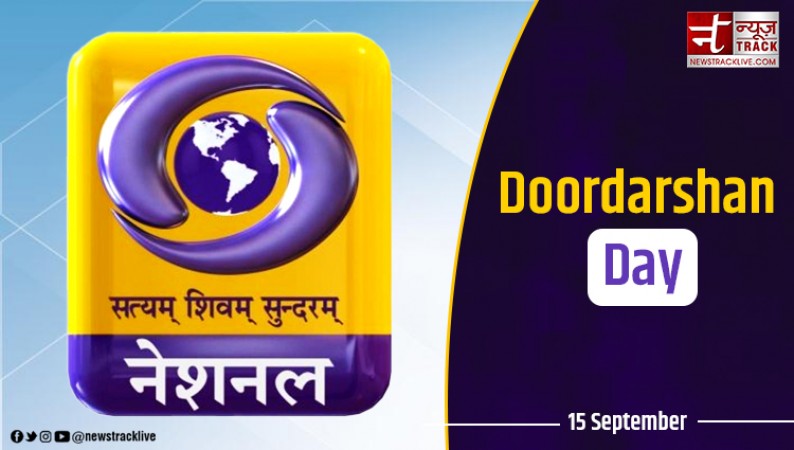
Doordarshan Day 2023: On the memorable day of 15th September 1959, the Indian Government initiated Doordarshan, commonly known as DD, the nation's public service broadcaster, in Delhi. What began as a small-scale experimental project, with a petite 5 KW transmitter and a makeshift studio, later emerged as a national broadcaster in 1982. Over the years, Doordarshan has played a pivotal role in shaping India's media landscape, serving as a window to the nation's cultural, social, and political diversity. As we celebrate Doordarshan Day on September 15th, let us take a comprehensive journey through the history, evolution, and impact of this iconic institution that has been an integral part of millions of Indian households.
The Inception of Doordarshan
The seeds of Doordarshan were sown in the mid-1950s when India was still a young republic. The need for a state-owned television broadcaster was felt to educate and entertain the masses while fostering national integration. The Information and Broadcasting Ministry spearheaded the project under the visionary leadership of Dr. S. Radhakrishnan, India's first Vice President and later President. The team faced numerous challenges, including technical constraints and a lack of infrastructure, but their unwavering commitment led to the birth of Doordarshan.
Doordarshan's Early Days
Doordarshan's early days were marked by resource constraints and limited programming. The first broadcast was a simple transmission of the President's address on September 15, 1959. The broadcast was black and white, and the signal covered only a small radius around Delhi. However, this humble beginning laid the foundation for what would become one of the largest broadcasting networks in the world.
The Expansion and Technological Advancements
As Doordarshan continued to grow, its reach expanded to cover more cities and regions. The introduction of color television in 1982 was a significant milestone that brought vibrancy to Indian homes. With advancements in technology, Doordarshan was able to offer a diverse range of programs, including news, entertainment, educational content, and cultural shows.
The Telecast of Iconic Shows
Doordarshan became synonymous with iconic shows that captured the hearts of millions. Programs like "Hum Log," "Ramayan," "Mahabharat," "Buniyaad," and "Malgudi Days" became cultural phenomena, bringing families together in front of the television set. These shows not only entertained but also carried moral and social messages that resonated with the audience.
Educational Outreach
One of the key objectives of Doordarshan was to provide educational content to viewers. The 'Krishi Darshan' series, dedicated to agricultural practices, played a crucial role in disseminating agricultural knowledge to rural communities. Similarly, the 'Turning Point' series provided career guidance and encouraged young minds to explore different fields. These educational programs had a profound impact on the lives of many and contributed to India's development.
Promotion of Arts and Culture
Doordarshan also played a vital role in promoting India's rich cultural heritage. The institution showcased classical music and dance performances, bringing renowned artists to the forefront. Programs like 'Bharat Ek Khoj' and 'Surabhi' celebrated the diversity of India's cultural traditions. The national broadcaster also covered major cultural events and festivals, allowing viewers to experience the cultural tapestry of the nation.
News and Information Dissemination
Doordarshan's news division has been a trusted source of information for decades. The daily news bulletin, "The National," delivered updates on national and international events to households across the country. Doordarshan's extensive network of correspondents ensured that even remote areas were covered. During times of crisis and emergencies, Doordarshan served as a reliable source of information, earning the trust of the people.
Evolution into a Multi-Channel Network
The liberalization of India's economy in the 1990s led to significant changes in the media landscape. Private television channels entered the scene, offering viewers a plethora of choices. In response, Doordarshan transformed itself into a multi-channel network, launching DD Metro and DD Sports, among others. This move allowed Doordarshan to cater to diverse audience preferences while retaining its public service ethos.
Digital Era and Online Presence
As India embraced the digital age, Doordarshan adapted to the changing media landscape. The launch of DD Free Dish, a free-to-air direct-to-home (DTH) service, ensured that Doordarshan's channels remained accessible to a wide audience. Doordarshan also expanded its online presence, streaming content on various platforms and launching its mobile app. This shift toward digital platforms allowed Doordarshan to reach a global audience and connect with the younger generation.
Challenges and Relevance
While Doordarshan has a storied history, it has also faced its share of challenges. Competition from private broadcasters, changing viewer preferences, and evolving technology have all posed challenges to the institution. However, Doordarshan has managed to stay relevant by adapting to these changes and continuing to provide quality programming that appeals to a broad audience.
Doordarshan Today
Today, Doordarshan remains an essential part of India's media landscape. It continues to provide a wide range of programming, including news, entertainment, sports, and cultural shows. Doordarshan also plays a vital role in promoting government initiatives, public awareness campaigns, and social messages.
As we celebrate Doordarshan Day on September 15th, it's a moment to reflect on the institution's remarkable journey. From its humble beginnings in 1959 to its current status as a multi-channel network with a strong digital presence, Doordarshan has played a significant role in shaping India's media landscape. It has entertained, educated, and informed generations of Indians, fostering national unity and celebrating the nation's rich cultural heritage. Doordarshan's enduring legacy is a testament to the power of public service broadcasting in a diverse and dynamic nation like India. It reminds us that, even in the age of digital media, there is a special place for an institution that serves the public interest and brings the nation together through the magic of television.